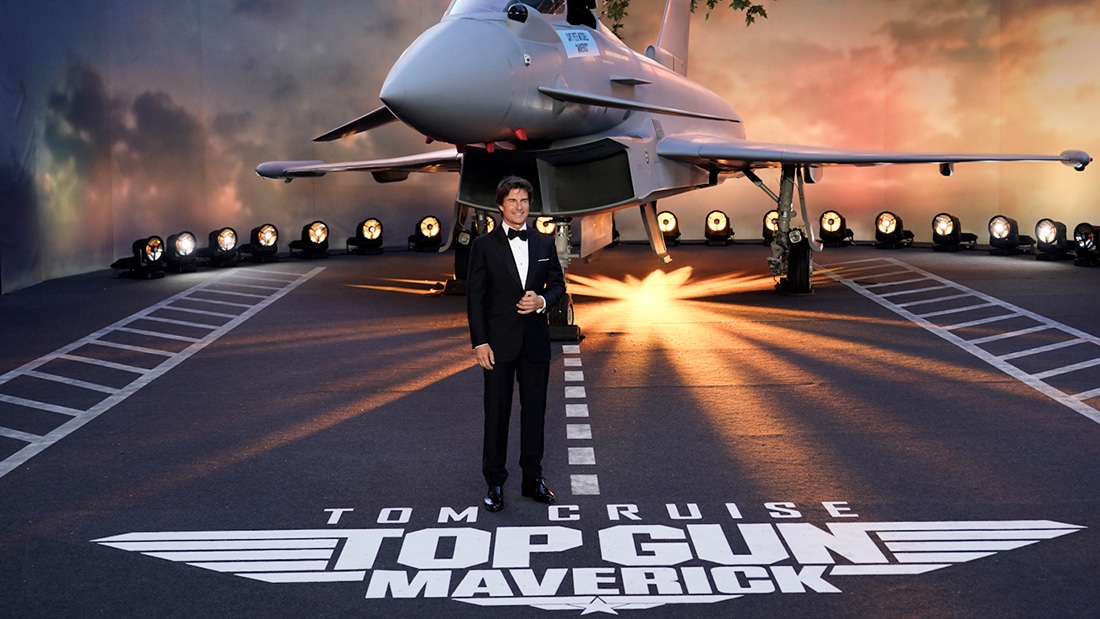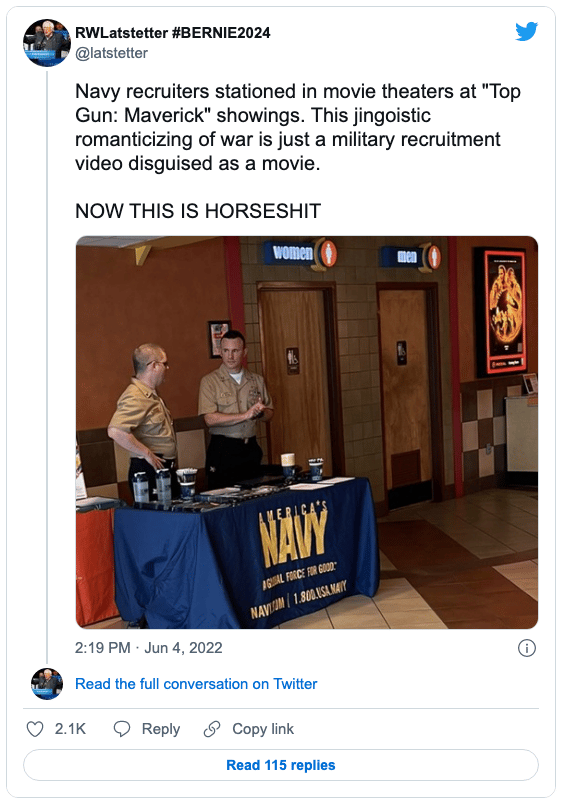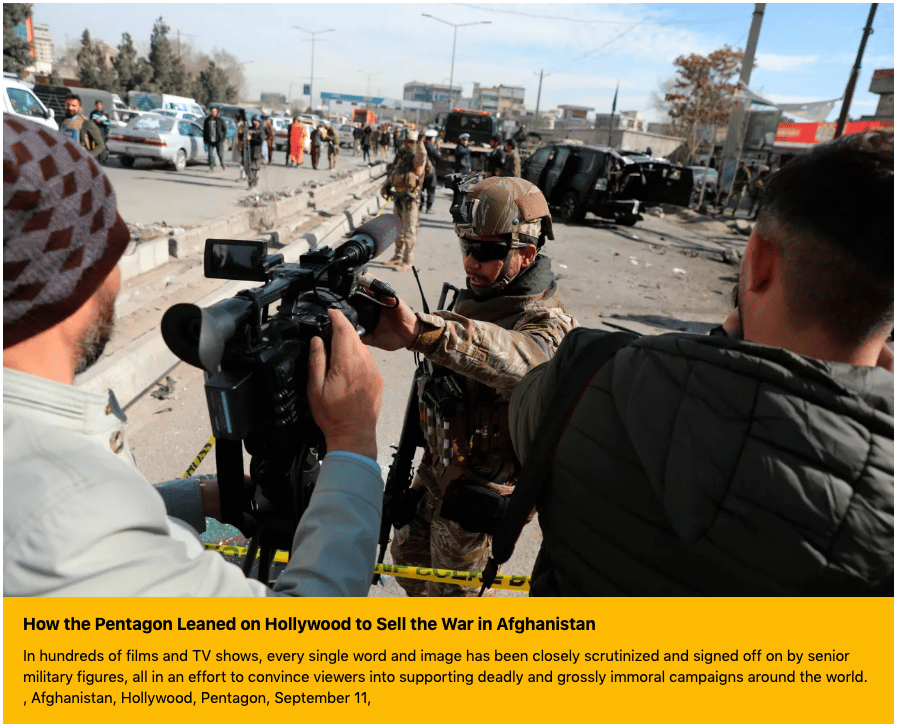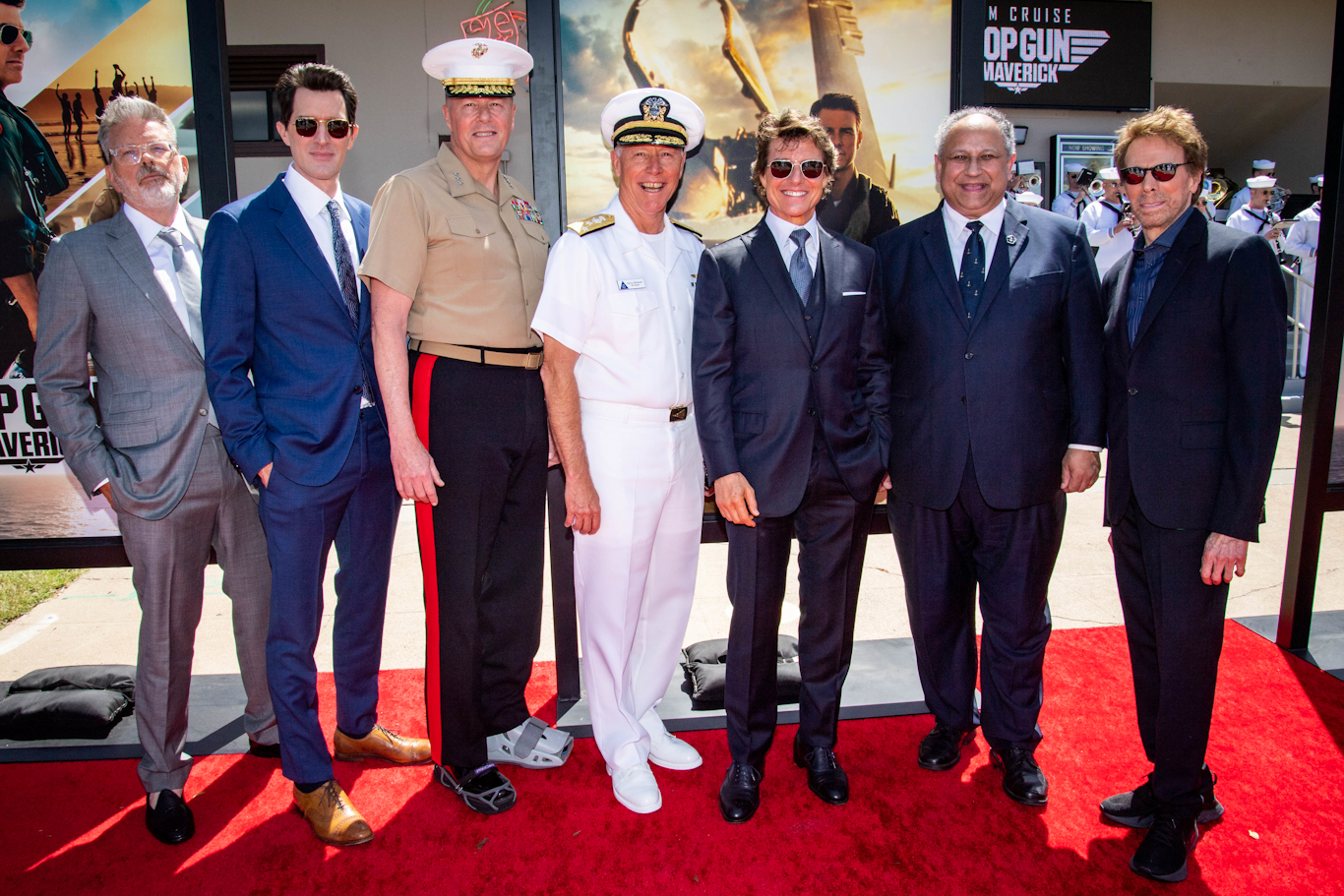Subscribe to Zero-Sum Pfear & Loathing



by Alan MacLeod | Jun 13, 2022
“Top Gun: Maverick” is a box-office smash, a massive hit with both critics and the public alike. Navy and Air Force units across the country have set up recruitment stalls inside movie halls, hoping to sign up individuals buzzed after watching the high-paced aviation action. But documents obtained under the Freedom of Information Act reveal that the movie was made only after an agreement was signed between Hollywood and the Pentagon, with the Navy insisting on “weav[ing] in” their “key talking points” in exchange for granting the production company extensive access to military hardware.
Investigative journalist Tom Secker, author of “National Security Cinema: The Shocking New Evidence of Government Control in Hollywood,” was one of those who obtained the documents. Secker explained that “Top Gun: Maverick” was made with an explicit agenda behind it, telling MintPress:
It’s about rehabilitation of the military’s image in the wake of numerous failed wars. The film also helps foreground human pilots flying an actual combat mission – something very rare in these days of high-altitude airstrikes and drone warfare. It helps distract from all the drone pilots who’ve spoken out about the misery and horror inherent in that job.”
The sequel to the hit 1980s movie “Top Gun,” the new film follows the story of Pete “Maverick” Mitchell over 30 years later, as the renegade pilot who does not play by the rules is brought in to train the Navy’s best young pilots for a secret mission to blow up a uranium enrichment facility [a site implied to be in Iran]. Maverick instead shows that he is still the best pilot and is selected for the mission himself.
The production agreement between the Department of Defense (DoD) and Paramount Pictures is an explicit quid pro quo. In exchange for all manner of technical support and access to military equipment and personnel, the Pentagon was allowed to “[a]ssign a senior staff, post-command Officer to review with public affairs the script’s thematics and weave in key talking points relevant to the aviation community.”
What these key talking points are, Secker felt, is not too difficult to work out. Throughout the movie, the phrase “it’s not the plane; it’s the pilot” is used. This comes at a time when the military is facing a pressing shortage of pilots – something that is completely incongruous if the glamorous image of hard drinking, woman-chasing daredevils living the high-octane life is anything like accurate.
In essence, then, the movie functions as a two-hour 11 minute-long recruitment ad for the military. As one recruiter told Fox News, “We want to take advantage of the opportunity to connect not just the movie and the idea of a military service, but the fact that we’ve got jobs and we’ve got recruiters waiting for them.”

Roger Stahl, professor of communications at the University of Georgia, told MintPress that movies play a key role in improving the military’s image at home and abroad, stating:
Foreign policy planners famously nicknamed the public’s reticence to authorize military intervention in the 80s the “Vietnam Syndrome.” The original “Top Gun’” arrived just in time to clean up this image and clear the way for a more palatable high-tech vision of imperialism and ultimately the Persian Gulf War. “Top Gun: Maverick” arrives at a similar moment in the shadow of Iraq and Afghanistan. And we will likely see a similar rebooting of the U.S. military machine.”
Stahl and Secker are co-producers of the new film “Theaters of War: How the Pentagon and CIA took Hollywood.”
In over 100 pages of contracts, the military agreed to allow Paramount access to a mountain of their most expensive hardware in exchange for what amounts to significant editorial control over the content and tone of the movie – an arrangement that is remarkably common in today’s environment.
“Top Gun: Maverick” was filmed at a number of military locations across the United States. This included air bases filled with the latest fighter jets and aboard two nuclear-powered aircraft carriers, the USS Theodore Roosevelt and the USS Abraham Lincoln. The production company was also allowed to borrow an F-14 Tomcat jet and to use a number of helicopters. The F/A-18 E/F Super Hornet, however, is the star of the show, with actors playing pilots being put through an extensive and rigorous training program, and the production company was given permission to attach cameras all over the inside and outside of the aircraft.
In addition, the Navy agreed to “[s]upport flying scenes with Naval aircraft and Naval aviators” and “[a]llow active-duty personnel in a duty status to appear in the film.” This included pilots, ground crew and sailors aboard Navy ships. Sweetening the deal, the Navy’s Blue Angel flight demonstration squad was instructed to perform a flyover for the production company.
Paramount was also given permission to purchase military uniforms. However, the Department of Defense effectively held a veto over any actor who appeared in the movie. As the agreement states,
The Production Company will cast actors, extras, doubles. and stunt personnel portraying Service members who conform to individual Military Service regulations governing age, height and weight, uniform, grooming, appearance, and conduct standards. DoD reserves the right to suspend support in the event that disagreement regarding the military aspects of these portrayals cannot be resolved in negotiation between the Production Company and DoD within the 72-hour cure period. The DoD Project Officer will provide written guidance specific to each Military Service being portrayed.
This is not a mere technicality. The DoD is intensely protective of its image in the media, going so far as to threaten to completely shut down the movie “12 Strong” (2018) merely because the production company intended to portray some U.S. soldiers with beards and/or tattoos.
This is far from the most onerous condition attached to the agreement, however. Clause 8 of the document, for instance, notes that the DoD approved a draft script of “Top Gun: Maverick” and that henceforth:
The Production Company must obtain, in advance, DoD concurrence for any subsequent substantial changes proposed to the military depictions made to either the Picture or the sound portions of the production before it is exhibited to the public.
Not only that, but Paramount must “involve the DoD Project Officer in these changes, including those that may be made during post-production.”
As a final check, clause 19 stipulates that the production company must provide to the military a final cut of the movie and allow the DoD to “confirm that the tone of the military sequences substantially conforms to the agreed script” and “[s]hould the Department of Defense determine that material in the production compromises any of the preceding concerns, the Department of Defense will alert the Production Company of the material, and the Production Company will remove the material from the production.” In other words, the Department of Defense is both co-writer and co-producer of the movie.
Should Paramount break this agreement, the terms were clear. The contract states that the military will permanently revoke the use of any images including its personnel or equipment, rendering the movie dead on arrival. Furthermore, the DoD notes that “Requests for future support…may also be denied.” To put it bluntly, anyone not producing a movie where every shot from every scene is not as the military wants it is blacklisted.
Despite effectively co-writing and co-producing the movie, the contract also demands that the extent of the military’s involvement must be downplayed. Clause 21a states that the military will be mentioned merely with the phrase “Special Thanks to the United States Department of Defense” in the end credits. No doubt the Pentagon is aware that the propaganda value of “Top Gun: Maverick” would be greatly diminished if moviegoers realized that this was an hours-long propaganda film produced by the military itself.
“Special Thanks” is a common phrase the DoD uses to hide its true role in Hollywood. Phil Strub, the Pentagon’s Hollywood liaison between 1988 and 2018, was possibly the most influential man in the entertainment industry. From the “Iron Man,, “James Bond,” “Jurassic Park” and “Transformers” franchises, to smash hits like “Apollo 13,” “Godzilla,” “Black Hawk Down” and “I Am Legend,” Strub’s resume is positively Spielbergian. Yet he is rarely credited with anything else but “special thanks,” despite the fact that documents show he wrote and rewrote movie scripts to suit the Pentagon’s agenda.
When pressed on its involvement in Hollywood, the Pentagon insists it is there merely to ensure that the military is presented as realistically as possible. Indeed, the “Top Gun: Maverick” production agreement states that its liaisons were there “to provide on-set dialogue and depict action scenes accurately.” Cruise, who played Pete “Maverick” Mitchell, is on the same page, stating that he demanded the movie “had to be as real as possible.”
Yet the entire premise of the movie – that Iran is developing a nuclear weapon and that the U.S. military would have to scramble together a plan to bomb the country in a matter of days – is absurd in itself. Maverick himself often egregiously breaks Navy rules, disobeying senior officers and stealing a plane – something that would never be tolerated. Furthermore, there are a number of crazy acrobatic stunts that are supposedly part of Maverick’s training program, including one where he flies directly between two of his students at a perpendicular angle, inches from destroying all three planes and ending their lives. This would be too dangerous even for choreographed routines from the Blue Angels, let alone for pilot training.
“‘Top Gun: Maverick’ most assuredly is not accurate,” Secker told MintPress, adding:
The entire premise of the film – just like in the first movie – is not true to life. But then, saying the entertainment liaison offices are there to help Hollywood present truthfulness or reality is like saying celebrities hire PR/crisis management firms because they sincerely want the public to be well-informed.”
Before his death, “Top Gun” director Tony Scott felt guilty about making a movie that glamorizes military life, lamenting:
All these kids must hate me, because they all signed on thinking they’re gonna be fighter pilots pulling broads all over the world, and they all ended up eleven stories down on some shitty old aircraft carrier stuck in the Indian Ocean.
Yet the reality of the profession is not just more boring, but far more grizzly. PTSD and suicide are exceptionally common in the profession, as pilots struggle to come to terms with the staggering amount of destruction they are required to carry out.

A US Navy sailor poses for photos with young moviegoers outside of a “Top Gun: Maverick” showing. Photo | DVIDS
Testimonies from a series of whistleblowers paint aerial war in a far less glorified and arguably much more realistic fashion. USAF Airman Daniel Hale leaked documents showing the Obama administration compiled detailed kill lists and that over 90% of the victims of the U.S. drone program, by even its own figures, were civilians. The Bureau of Investigative Journalism estimates that U.S. drone pilots have killed between 4,126 and 10,076 people in Afghanistan alone.
“When I fired my first shot and killed people, that was heartbreaking for me, because I didn’t think that I would ever be in a position that I would have to take someone else’s life,” said USAF sensor operator Brandon Bryant. “I felt like it destroyed my soul… It has isolated me. I stopped sleeping because I started dreaming about my job and couldn’t escape it at all,” he added.
Perhaps the most infamous leak revealing the realities of pilot life, however, is the Collateral Murder video. In it, U.S. Apache helicopter pilots are seen ruthlessly opening fire on a crowd of people in Baghdad, killing at least 12, including two Reuters journalists. As the attack continues, the pilots even laugh and shoot at civilians medically assisting the victims. While the leaker and publisher responsible for the world seeing those images went to prison, those presenting the sanitized, glorified version of military life are hot favorites to receive Academy Awards this year.
Thus, just as there are no scenes in “Top Gun: Maverick” of screaming Iranian children picking through the remains of their dead family, any “Top Gun 3” is unlikely to revolve around Tom Cruise struggling with PTSD caused by the unimaginable violence in which he has participated.
“Top Gun: Maverick” has been produced at a time when the United States is currently throttling Iran with illegal and deadly sanctions. In early 2020, the Trump administration assassinated top Iranian general and statesman Qassem Soleimani, and influential figures in the United States have called for an unprovoked nuclear attack on the country.
Yet none of this context is mentioned, leaving the legality of the depicted attack unquestioned. As Stahl told MintPress, the basic assumption is that “the U.S. has the right to violate international law and strike any country for any reason.” “Imagine if this film came out of Iran and was about striking an Israeli or U.S. nuclear facility,” he said. “Heads would explode with accusations of hard-line propaganda.”
Therefore, “Top Gun: Maverick” falls in line in promoting a remarkably militaristic society; one that spends almost as much on war as every other nation on Earth combined. Celebrations of militarism are everywhere in the United States, from sporting events to cinemas, feeding into an overwhelming cult of troop worship.
The military works exceptionally hard to maintain a positive image and has found a willing collaborator in the entertainment industry. Stahl and Secker’s investigations have found that the Pentagon and CIA have exercised direct control over more than 2,500 films and television shows. These include not only military-based blockbusters like “American Sniper,” “Pearl Harbor” and “A Few Good Men,” but also a host of light entertainment shows like “The Price is Right,” “Teen Idol” and “The Ellen DeGeneres Show.” A decent rule of thumb is that if the title you are watching includes the military or security services, then those institutions will likely be co-producing the work, meaning they themselves decide how they are depicted.

US Navy brass pose for a photo with Tom Cruise at Naval Air Station Whidbey Island. Photo | DVIDS
The military opens its doors to directors and producers across the country, offering them free or special access to its arsenal of machines that would be impossible to obtain otherwise, access to military bases for filming, and use of active-duty personnel as extras, as well as a host of other benefits that would be impractically expensive otherwise. But he who pays the piper calls the tune, and the Pentagon exacts a considerable political cost, insisting that the creative direction and outlook of the film or TV show is as relentlessly pro-military as it is possible to get. Anti-war productions need not apply and therefore are rejected out of hand by the majority of production companies, who do not want to lose such a powerful ally.
In this sense, then, film and television in America have slowly turned into a military-entertainment complex in which hundreds of millions of Americans are fed a steady diet of Pentagon-sponsored pro-war propaganda. And they are not even aware of it.
At one time, Cruise felt a good deal of remorse for becoming part of the war machine, telling Playboy magazine:
Some people felt that “Top Gun’”was a right-wing film to promote the Navy. And a lot of kids loved it. But I want the kids to know that that’s not the way war is – that “Top Gun” was just an amusement park ride, a fun film with a PG-13 rating that was not supposed to be reality. That’s why I didn’t go on and make Top Gun II and III and IV and V. That would have been irresponsible.”
Irresponsible it may be, but judging by the fact that Cruise will receive a significant cut of the global box office figures ($747 million and counting), at least he will be financially compensated for it. In the same Playboy interview, Cruise also lamented that he could be “totally responsible for World War Three.” Given the United States’ constantly aggressive actions towards Iran, he might one day be proven correct.